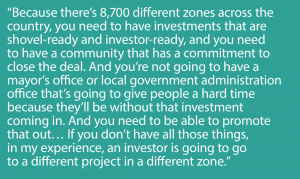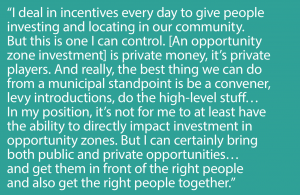Getting in the zone
As the lead for Knox Law Public Strategies, Tim Wachter provides consulting services for public and private clients on opportunity zones (OZs) and funds, as well as economic development, public policy and other related subjects. Wachter has testified about OZs to the Pennsylvania House of Representatives’ Urban Affairs Committee, and he’s considered a national thought leader on OZs.
When he first learned about OZs though, Wachter’s gut reaction was surprise.
“I couldn’t believe it,” he recalls. “It was a tax incentive that came out of strong public policy, good public policy, and it looked like it could work. It was actually quite shocking to see something that could be so beneficial for a community, coming out of what appears to be a dysfunctional Washington, D.C.”
There is a lot of inherent promise in OZs. The Economic Innovation Group estimates that there are $6.1 trillion worth of unrealized capital gains in the U.S. That equals nearly 30 percent of the national debt.
“There hasn’t been a good reason, a public policy or tax reason for [people who hold these capital gains] to realize those capital gains, and then make the decision to invest them into these lowincome census tracts,” Wachter says.
The Tax Cuts and Jobs Act, signed into law on Dec. 22, 2017, changed that.
The act created OZs, which are state-nominated census tracts in which eligible capital investments can qualify for deferrals of taxes on those capital gains, according to the Internal Revenue Service (IRS).
The IRS defines OZs as being economically distressed communities, and the tax benefits vested in OZs are designed to spur economic development in those areas. OZs also get preference and priority in many federal spending programs.
So, while an investor can certainly benefit by deferring taxes on an OZ investment’s capital gains, investment in low-income areas can benefit cities, too.
“As a project owner, as a community, you should be interested in promoting your project, promoting your community, so that these dollars can then come in that haven’t been available before,” Wachter says.
Cities can attract federal spending into OZs with the preference and priority that many federal programs give to those areas. But otherwise, the private sector leads the OZ investment dance — investors can pool their money where they want, and they don’t need to get government approval to invest in an OZ. Given that, what can local governments do to promote investment in their local OZs?
As experts show, cities have three ways to promote the OZs in their communities: policy, creating a prospectus and serving as a convener and educator.
Policy pragmatism
 OZ experts say there are a few traditional, policy- specific tools that governments have at their disposal to promote investment into local OZs.
OZ experts say there are a few traditional, policy- specific tools that governments have at their disposal to promote investment into local OZs.
Knowledge of property conveyance rules is one such tool, says C. Tyler Mulligan, a professor of public law and government at the University of North Carolina’s School of Government. Before selling property in an OZ, a local government should know its legal ability to impose conditions on potential property buyers. Zoning, however, is governments’ primary regulatory tool when it comes to OZs, he says.
Say for example, that investors are looking at similar census tracts for an investment. “If it’s going to be a lot easier to go to Community A because they have decided to make it easier because of zoning, because of paperwork… that’s a game changer for people that are going into these communities, because the clock’s running,” says Michelle Christian, national director of the U.S. Small Business Administration’s Office of Rural Affairs.
State and local incentives are important, Christian says. Because communities of similar sizes, demographics and needs could be competing for investments, those incentives could be a reason why an investor might choose to invest in a project in one area versus another.
Because OZ investing is private investor led though, Wachter believes that a major part of cities attracting investment is to just promote the community.
“What you need to do is promote your community as a place that is attractive for investment to occur, and promote those projects that are both socially impactful and economically viable,” he says. “And then step out of the way and let the private market handle it.”
That’s where a prospectus comes into play.
The power of a prospectus
South Bend, Ind., is one city that emerged early with a keen interest in promoting its OZs. In 2018, South Bend worked with New Localism Advisors and Accelerator for America to be one of the first cities to release an investment prospectus.
Developed by New Localism Advisors, the investment prospectus is designed to, “enable cities, counties and states to identify concrete investable projects and propositions in designated Opportunity Zones,” according to a post on founders Bruce Katz and Jeremy Nowak’s website for their book, “The New Localism.”
Released in December 2018, South Bend’s prospectus provides numbers, explanations and lists that illustrate the city’s economy, assets, opportunity zone tracts and community, as well as specific catalytic projects in the city.
“In a lot of ways, [the prospectus] just helped put us on the map early,” South Bend Director of Business Development Dan Buckenmeyer says. “Before opportunity zones even were a big story, we were part of that lead for a lot of folks, and it just helped us get some early wins in terms of having some conversations and even getting some early deals lined up.”
Stockton, Calif., was another early adopter of the tool — it too, worked with Accelerator for America to develop its prospectus, which was also released in December 2018.
“When you jump on all kinds of calls with different groups of people, it’s used as a sample of what a city can do to attract investors to opportunity zones,” says Stockton Director of Economic Development Carrie Wright.
Working with Accelerator for America and doing such a deep dive into OZs eliminated the need for South Bend to work with consultants in later stages, Buckenmeyer says. However, he has also found consulting aid closer to home — attorneys, CPAs, and other firms in the South Bend community have deep knowledge of
OZs and have helped with local OZ-related deals.
Engaging community members like this fits with Buckenmeyer and Wright’s ongoing approaches to attracting OZ investment: by being conveners of stakeholders and investors.
“This is private money, this is private players,” Buckenmeyer says. “Really, the best thing we can do from a municipal standpoint is be a convener, levy introductions, do the high-level stuff.”
Bringing stakeholders together is also the first step of what Wachter calls the five phases of OZ development.
Convening the community
For Wachter, the first step to realizing OZ development is bringing stakeholders in a community together and educating them on what OZs are, how they work and why people should care about them.
Christian concurs. “You want to make sure everybody is brought to the table in these communities so that they can figure out what’s needed and then go to the next level and try to attract investors,” she says. “So, determine what you need. What is it that we need in our community, and who are the players that should be at the table to determine that?”
Around February and March, South Bend officials threw a major event for the community to introduce OZs to them, Buckenmeyer says. Officials set up round tables, invited community members and began educating them on OZs, how to formulate deals, what deals are eligible and more. The city also promised to reconvene for more workshops if needed.
“It’s not for me to at least have the ability to directly impact investment in opportunity zones,” Buckenmeyer says. “But I can certainly bring both public and private opportunities… and get them in front of the right people and also get the right people together.”
While educating stakeholders, cities should be identifying potential investors and educating them on what projects may look like and why they should invest in them, according to Wachter.
“You need to be able to identify those local and regional investors who can create capital gains and may be interested in not only having an economic return, but also being able to see the social impact of your investment as well,” he says.
Stockton is taking two major actions to attract investors. First, the city was set to hold a seminar in December targeted to bringing local developers together. Through the seminar, officials want to ensure that those within the Stockton market understand the opportunities available, Wright says.
“One of the challenges that we found with opportunity zones is that not everyone knows how to use them or what value they bring,” she says.
 In April 2020, Stockton will host an investors’ summit to bring people from outside Stockton into the city to showcase local OZs, city programs and California state incentives, according to Wright. The summit will consist of tours and meetings with city staff and locals.
In April 2020, Stockton will host an investors’ summit to bring people from outside Stockton into the city to showcase local OZs, city programs and California state incentives, according to Wright. The summit will consist of tours and meetings with city staff and locals.
Cities should also identify projects — qualified businesses to invest in, or real estate projects that can accept investment and are ready to accept it, Wachter says. The projects should be shovel-ready and investor-ready.
If cities have strategically positioned property in an OZ, they should do some pre-development analysis to determine if there’s an attractive investment or opportunity there for investors, Mulligan says. He’s observed that some local governments in North Carolina have inventoried land they already own in OZs and assessed if they should make it available for investment.
A couple of local governments in the state have also acquired new land in OZs when they realized it fit in with their strategic goals, Mulligan adds. The fourth and fifth steps for realizing OZ development are opportunity fund development and project promotion, according to Wachter.
“There’s a lot of competition, and if you’re not in a first-level investment market, you need to… focus on getting above the noise and getting eyeballs on your projects,” Wachter says.
A lot of competition might be an understatement — there are 8,766 census tracts across all 50 states, Washington and six territories that are certified as OZs.
Inevitably, not every OZ will see investment in it. So, what good are OZs if your community can’t attract any investments into them?
As it turns out, OZs are still extremely valuable for a wholly unrelated reason.
Show me the (federal) money
OZs contain a major benefit that has nothing to do with private investment or capital gains.
It came into play just under a year after the Tax Cuts and Jobs Act was initially passed, when President Donald Trump signed an executive order on Dec. 12, 2018.
The executive order established the White House Opportunity and Revitalization Council. The council identified over 160 federal spending programs to give preference, prioritization, increased targeting or additional support to OZs, according to Wachter and federal documents.
So, for example, OZs are now priority consideration areas for selection in the 2019 solicitation for the U.S. Department of Justice’s Enhancements to Juvenile Indigent Defense program, which supports states and localities. More information on applicable spending programs can be found online at opportunityzones.gov.
“There’s so much here,” Christian says. “It’s just such a bigger package than the capital gains incentive.”
Learning about the existence of these preference points or prioritization points in OZs for grants is particularly important for rural and smaller communities, since they tend to face challenges that urban communities don’t necessarily have, while sometimes lacking the resources to address them, Christian says.
So, even if a city cannot identify an OZ-related project for investors to invest in, it should identify where federal spending can go, Wachter says.
The use of federal funds in OZs could, of course, also make a community more attractive for OZ-related investment, too.
But time is of the essence.
“They need to act on this now, while it’s here, while it can help them,” Christian says. “Because these investors are looking, and let’s help these communities get those investors and change the community for generations.”




















